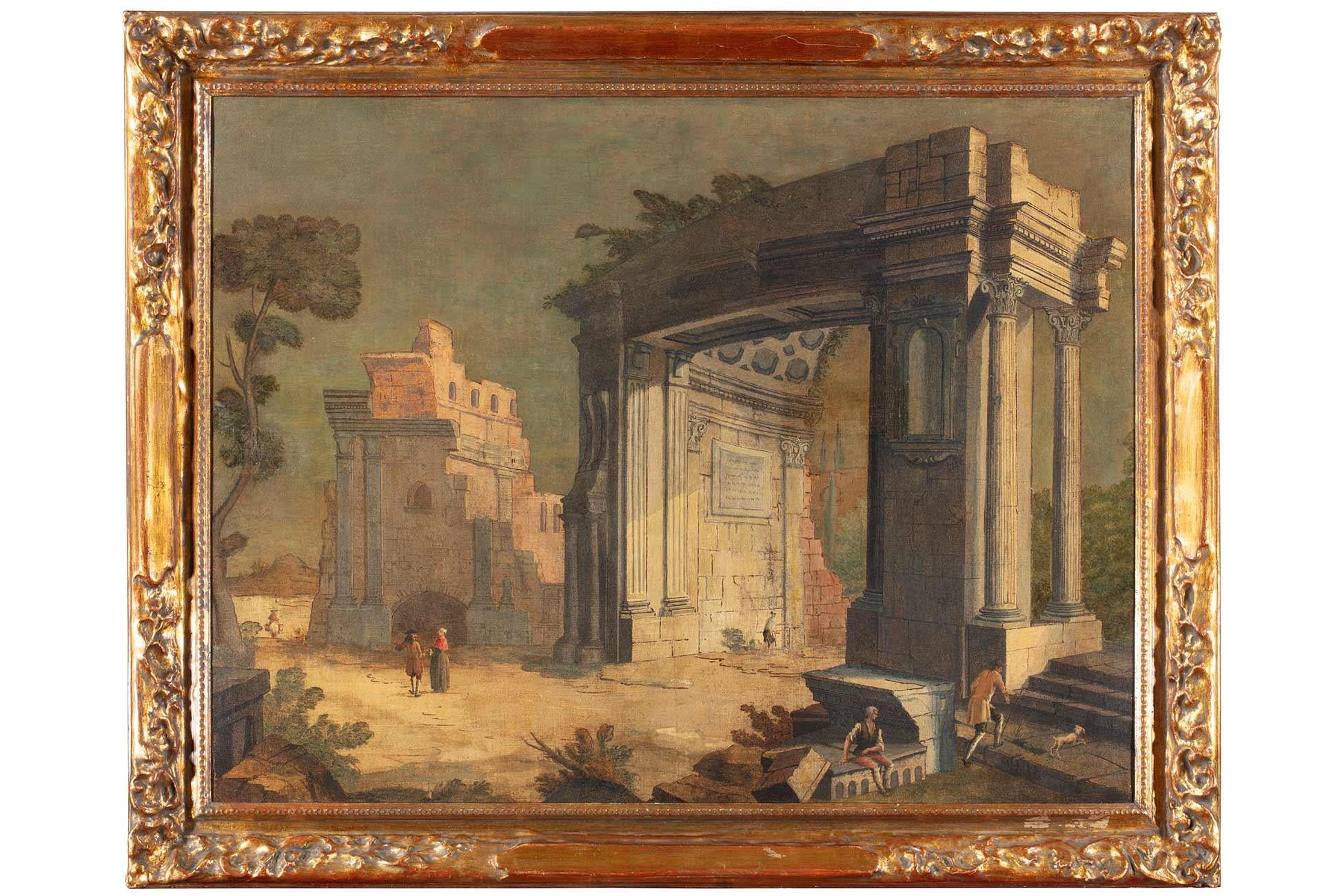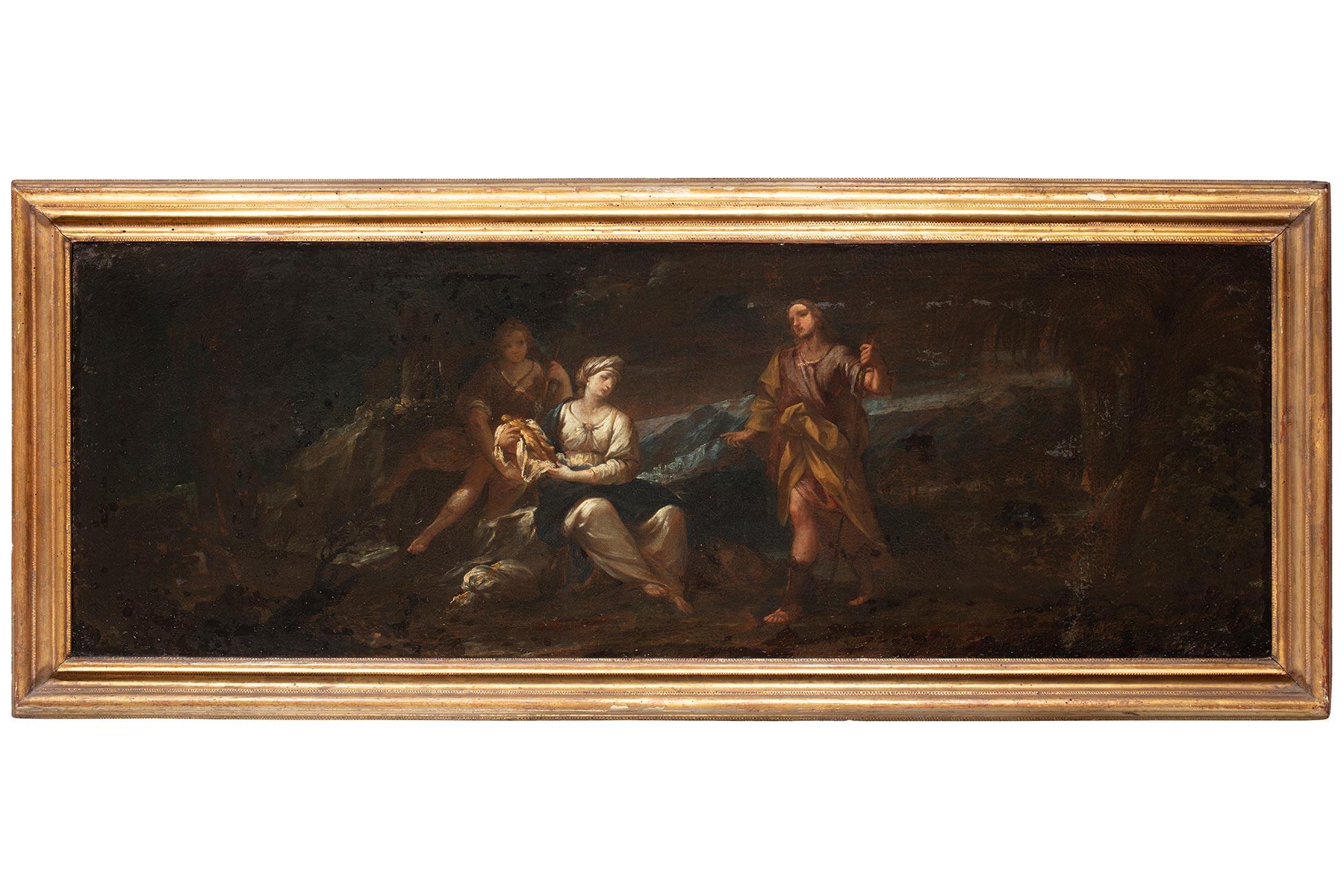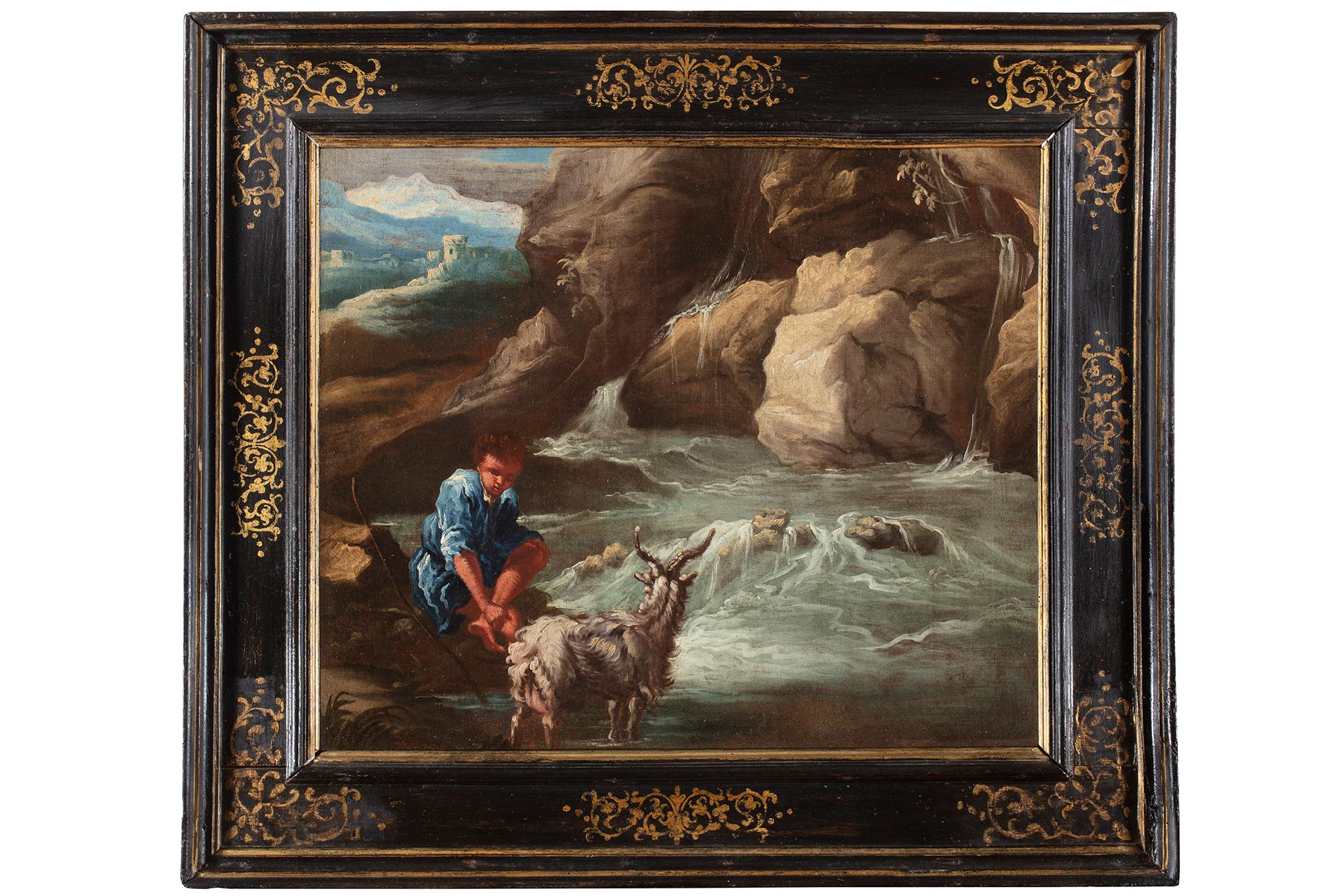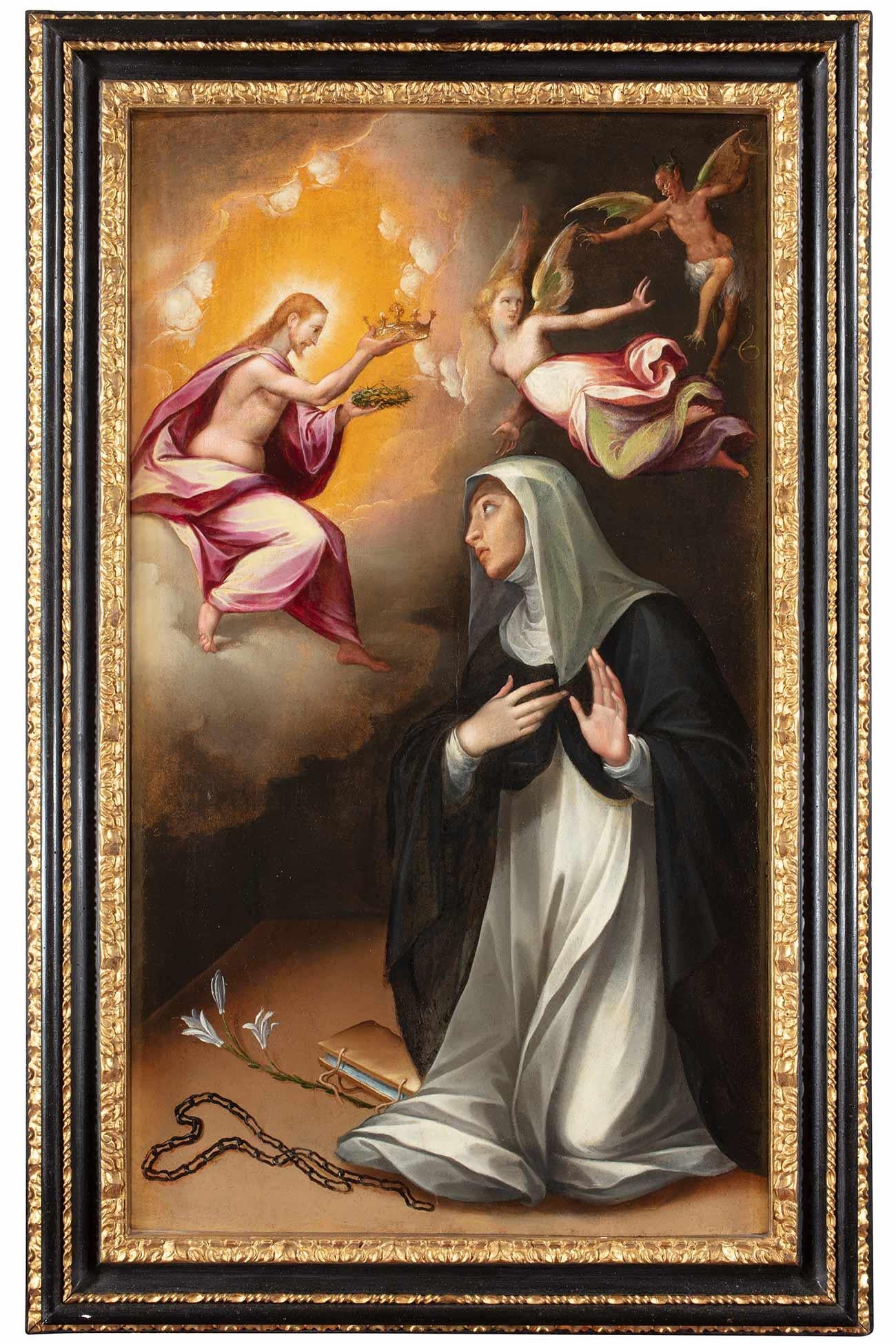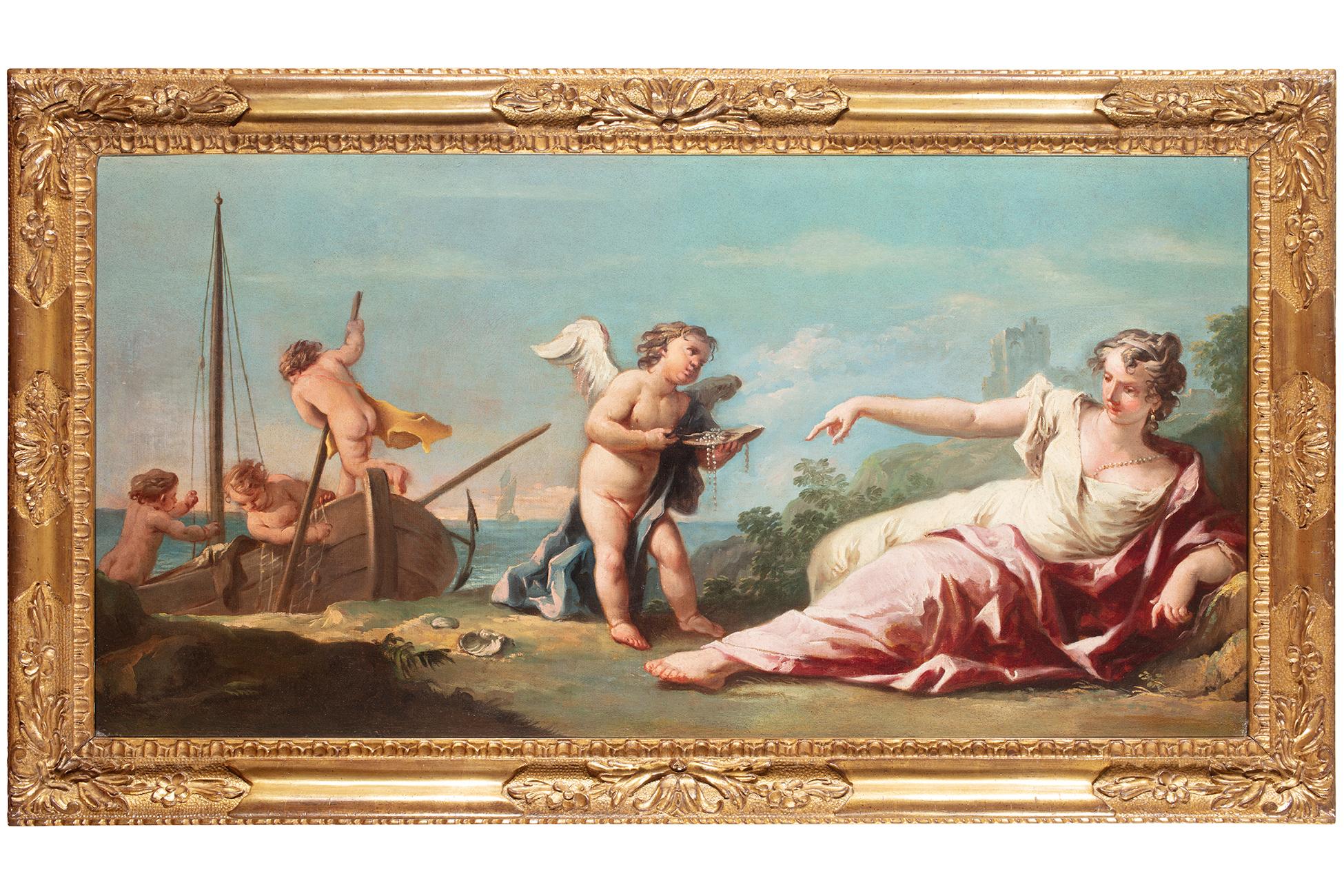Items Similar to 19th Century By Giustino Menescardi Ascent to Calvary Oil on Canvas
Want more images or videos?
Request additional images or videos from the seller
1 of 10
Giustino Menescardi19th Century By Giustino Menescardi Ascent to Calvary Oil on CanvasLate 18th Century
Late 18th Century
About the Item
Giustino Menescardi (Milan, c. 1720 - Venice, after 1779)
Ascent of Calvary
Oil on canvas, cm. 47 x 36 - with frame cm. 57x43
Shaped and gilded wooden cassetta frame
Publications: Bozzetti, modelletti, sketches: dalla collezione di Giorgio Baratti (From the Giorgio Baratti Collection) curated by Anna Orlando, Agnese Marengo and Annalisa Scarpa, Genova, 2022, pp. 62, 63.
This painting is the work of Giustino Menescardi, one of the most talented artists who followed Tiepolo's painting. The scene depicted is that of the ascent to Calvary, the mountain on which Jesus Christ was crucified. In the foreground we can see the figure of Christ, dressed in red and crowned with thorns, falling under the weight of the cross carried on his shoulder. The figure of the henchman on the right of the composition is particularly valuable, revealing the painter's stylistic affiliation with the Venetian artistic milieu, an exquisite genre figure.
- Creator:Giustino Menescardi (1720 - 1780, Italian)
- Creation Year:Late 18th Century
- Dimensions:Height: 18.51 in (47 cm)Width: 14.18 in (36 cm)Depth: 1.97 in (5 cm)
- More Editions & Sizes:57 x 43 cm with frame Price: $14,375
- Medium:
- Movement & Style:
- Period:
- Condition:
- Gallery Location:Milano, IT
- Reference Number:1stDibs: LU170129769072
About the Seller
5.0
Vetted Seller
These experienced sellers undergo a comprehensive evaluation by our team of in-house experts.
Established in 1964
1stDibs seller since 2021
- ShippingRetrieving quote...Ships From: Milano, Italy
- Return PolicyA return for this item may be initiated within 14 days of delivery.
More From This SellerView All
- 17th Century by Simone Cantarini Adoration of The Magi Painting Oil on CanvasLocated in Milano, LombardiaSimone Cantarini (Pesaro 1612 - Verona 1648) Adoration of the Magi Oil on paper applied to canvas, cm. 16,5 x 24 – with frame cm. 22 x 29 Antique sh...Category
Early 17th Century Old Masters Figurative Paintings
MaterialsCanvas, Cotton Canvas, Oil
- 18th Century by Antonio Stom Architectural Capriccio Oil on Canvas_By Antonio StomLocated in Milano, LombardiaAntonio Stom (Venice c. 1688 - 1734) Architectural Capriccio oil on canvas, cm. 88 x 113 - with frame cm. 106 x 132 Carved, sculpted and gilded wooden frame Expertise: Giancarlo S...Category
Early 18th Century Old Masters Landscape Paintings
MaterialsCanvas, Cotton Canvas, Oil
- 17th Century by Felice Torelli Rachel Hiding the Idols Oil on CanvasLocated in Milano, LombardiaFelice Torelli (Verona 1667 - Bologna 1748) Rachel Hiding the Idols Oil on canvas, 41 x 116 cm without frame - 52,5 x 127 cm with frame Original shape...Category
Late 17th Century Old Masters Landscape Paintings
MaterialsCanvas, Cotton Canvas, Oil
- 18th Century by Giuseppe Pianca Shepherd with Goat and River Oil on CanvasLocated in Milano, LombardiaGiuseppe Antonio Pianca (Agnona di Borgosesia/VC, 1703 - after 1757) oil on canvas, cm. 49 x 57 - with frame cm. 67 x 77 Antique shaped wooden cassetta frame, ebony and gold decora...Category
18th Century Old Masters Landscape Paintings
MaterialsCanvas, Cotton Canvas, Oil
- 16th Century by Cristofano Roncalli Saint Catherine of Siena Oil on CanvasLocated in Milano, LombardiaCristofano Roncalli (Pomarance 1552 - Rome 1626) Saint Catherine of Siena chooses the crown of thorns oil on wood, cm. 101,5x59.5 - with frame cm. 120x76 Shaped, carved and sculpted wooden cassetta frame, partly gilded and partly ebonized wood Expertise: Marco Ciampolini The marvellous scene that opens before our eyes is that of Christ's apparition to Saint Catherine of Siena; she must choose between a golden crown, the symbol of earthly royalty, and a crown of thorns, the symbol of virtuous Christian sacrifice. Catherine does not hesitate to choose the crown of thorns, her life in imitation of...Category
16th Century Old Masters Landscape Paintings
MaterialsCanvas, Cotton Canvas, Oil
- 18th Century by Gaspare Diziani Venus With Cupid Oil on CanvasBy Gaspare DizianiLocated in Milano, LombardiaGaspare Diziani (Belluno, 1689 - Venice, 17 August 1767) Gilded, carved and sculpted wooden cassetta frame Expertise: Ugo Ruggeri The narration of our...Category
Early 18th Century Old Masters Landscape Paintings
MaterialsCanvas, Cotton Canvas, Oil
You May Also Like
- A WolfLocated in New York, NYProvenance: The Marchesi Strozzi, Palazzo Strozzi, Florence Sale, Christie’s, London, May 20, 1993, lot 315, as by Carl Borromaus Andreas Ruthart...Category
17th Century Old Masters Animal Paintings
MaterialsCanvas, Paper, Oil
- Early oil depicting the Great Fire of LondonLocated in London, GBThe Great Fire of London in September 1666 was one of the greatest disasters in the city’s history. The City, with its wooden houses crowded together in narrow streets, was a natural fire risk, and predictions that London would burn down became a shocking reality. The fire began in a bakery in Pudding Lane, an area near the Thames teeming with warehouses and shops full of flammable materials, such as timber, oil, coal, pitch and turpentine. Inevitably the fire spread rapidly from this area into the City. Our painting depicts the impact of the fire on those who were caught in it and creates a very dramatic impression of what the fire was like. Closer inspection reveals a scene of chaos and panic with people running out of the gates. It shows Cripplegate in the north of the City, with St Giles without Cripplegate to its left, in flames (on the site of the present day Barbican). The painting probably represents the fire on the night of Tuesday 4 September, when four-fifths of the City was burning at once, including St Paul's Cathedral. Old St Paul’s can be seen to the right of the canvas, the medieval church with its thick stone walls, was considered a place of safety, but the building was covered in wooden scaffolding as it was in the midst of being restored by the then little known architect, Christopher Wren and caught fire. Our painting seems to depict a specific moment on the Tuesday night when the lead on St Paul’s caught fire and, as the diarist John Evelyn described: ‘the stones of Paul’s flew like grenades, the melting lead running down the streets in a stream and the very pavements glowing with the firey redness, so as no horse, nor man, was able to tread on them.’ Although the loss of life was minimal, some accounts record only sixteen perished, the magnitude of the property loss was shocking – some four hundred and thirty acres, about eighty per cent of the City proper was destroyed, including over thirteen thousand houses, eighty-nine churches, and fifty-two Guild Halls. Thousands were homeless and financially ruined. The Great Fire, and the subsequent fire of 1676, which destroyed over six hundred houses south of the Thames, changed the appearance of London forever. The one constructive outcome of the Great Fire was that the plague, which had devastated the population of London since 1665, diminished greatly, due to the mass death of the plague-carrying rats in the blaze. The fire was widely reported in eyewitness accounts, newspapers, letters and diaries. Samuel Pepys recorded climbing the steeple of Barking Church from which he viewed the destroyed City: ‘the saddest sight of desolation that I ever saw.’ There was an official enquiry into the causes of the fire, petitions to the King and Lord Mayor to rebuild, new legislation and building Acts. Naturally, the fire became a dramatic and extremely popular subject for painters and engravers. A group of works relatively closely related to the present picture have been traditionally ascribed to Jan Griffier...Category
17th Century Old Masters Landscape Paintings
MaterialsOil, Canvas
- The Parade of Swiss Guards a painting on canvas by Gabriel de Saint-AubinLocated in PARIS, FRIn this painting, Gabriel de Saint-Aubin, the great chronicler of the reign of Louis XV, takes us to the annual parade of the Swiss Guards at the Plaine de...Category
1760s Old Masters Figurative Paintings
MaterialsCanvas, Oil
- View of Ponte Milvio in RomeLocated in Roma, RMNorthern painter active in Rome in the second half of the 17th century, View of Ponte Milvio Oil painting on canvas 73 x 97 cm in coeval Roman Salvator Rosa frame.Category
18th Century and Earlier Old Masters Landscape Paintings
MaterialsCanvas, Oil
- Allegory of four elements, pupil of Jan Brueghel the Younger (1601-1678)Located in PARIS, FR17th century Antwerp school Landscape, animals and stilllife by a pupil of Jan Brueghel the Younger (1601-1678) Figures by a pupil of Frans Francken II Oil on canvas: h. 52,5 cm, w. ...Category
Mid-17th Century Old Masters Figurative Photography
MaterialsCanvas, Oil
- Louis XIV and his army at the crossing of the Rhine by Adam-Frans van der MeulenBy Adam Frans van der MeulenLocated in PARIS, FRAdam-Frans van der Meulen (Bruxelles, 1632 - Paris, 1690) Louis XIV and his army at the crossing of the Rhine 12 June 1672 Signed A.F VANDERMEULEN at the right low corner Oil on can...Category
1670s Old Masters Landscape Paintings
MaterialsCanvas, Oil
Recently Viewed
View AllMore Ways To Browse
Christ Figure
Antique Paintings Of Jesus
Old Master Paintings Venice
Old Masters Paintings Of Venice
Antique By Anna
18th Jesus
18th Century Sketch
Venice Dress
Jesus Christ Paintings
18th C Cross
Revealing Dress
Venetian Painted Gilded
18th Century Oil Genre Paintings
18th Century Venetian Paintings
18th And 19th Century Landscape Oil Painting
Crown Thorns
Crown Of Thorns
Old Master Oil Paintings Venice

